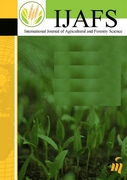Volume 1, Issue 1, 2016

Mcmed International
International Journal of Agricultural and Forestry Sciences
Issn
XXX-XXXX (Print),
XXXX-XXXX (Online)
Frequency
bi-annual
Email
editorijafs@mcmed.us












